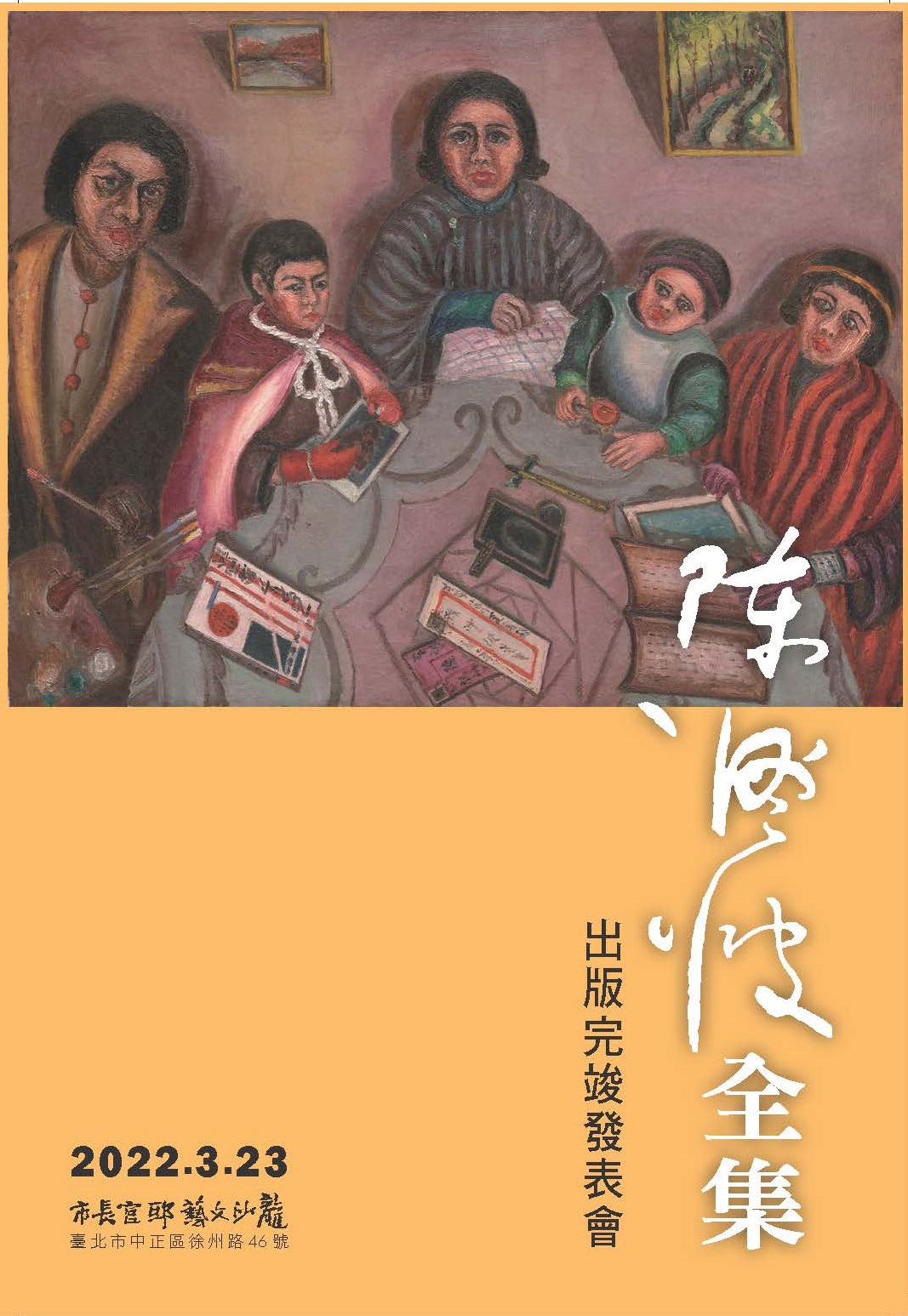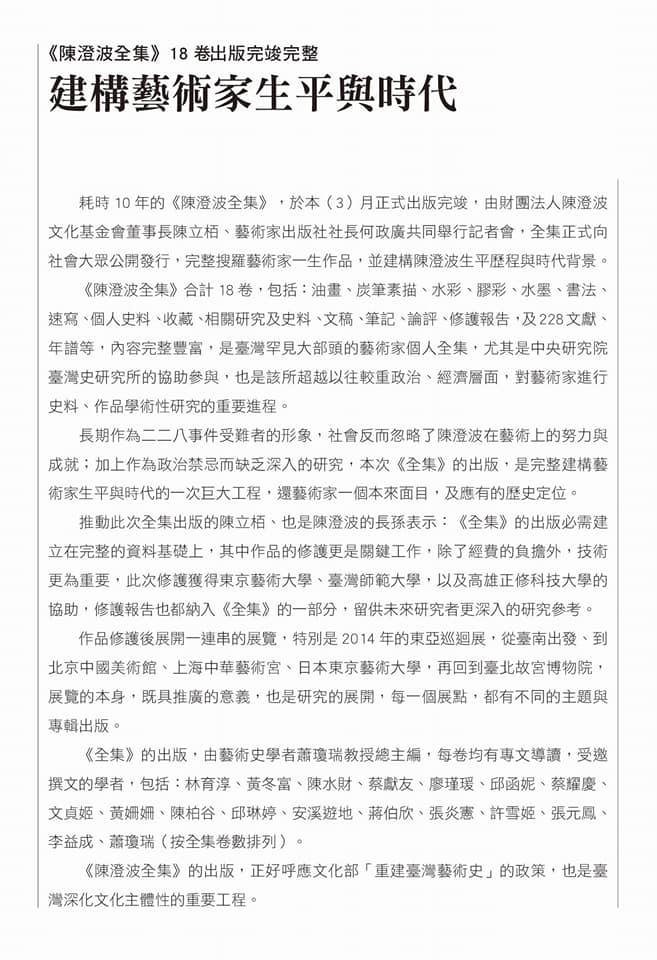![]()
陳澄波全集)全18巻完結! 発表会の案内が届きました。 RT_@tiniasobu
2022/03/23
2021年9月に解説原稿を送った、台湾の画家・陳澄波全集 第11巻の校正と英語から中國語訳への翻訳が完成したと思ったら、それと同時に、全巻完結となることがわかりました。
http://ankei.jp/yuji/?n=2564 で書いていますが、この仕事を頼まれた日が狭心症に気づいた日でした。そのため、仕事が遅れてご迷惑をかけましたが、なんとか間に合ったということです。
|323,《陳澄波全集》出版完竣發表會|
2012-2022,耗時整整10年
《陳澄波全集》合計18卷,完工!!
對於編輯《陳澄波全集》的我們來?,10年好像很長。但與陳家人相比,他們?經藏匿、公開、修復這些作品、文件,花了65年的?月(1947-2012),我們這些後輩的10年,實在太短。
今年是陳澄波逝世75年,基金會沒有大型的紀念活動,僅以《陳澄波全集》的完成來還原一個藝術家本來面目。
3月23日(三)下午2:00,《陳澄波全集》出版完竣發表會,於市長官邸藝文沙龍舉行,邀請這一路上協助基金會的老師、夥伴們一同出席。
以下は、解説文の書き出しの部分です。 17ページ書いてといわれて、55ページかいてしまったのでした。
Teacher, Artist, and Politician: Chen Cheng-po’s Vocations as Hinted in
His Notebooks
ANKEI Yuji (安溪遊地), YOSHINAGA Nobuyuki (吉永敦征), IZAO Tomio (井竿富?)1
Introduction
A. Chen Cheng-po’s lifetime and his three notebooks
In the collection of Chen Cheng-po Cultural Foundation (the
Foundation),2 there exist three notebooks. The first notebook, labeled A
Collection of Essays (the Collection), was started on January 1, 1915
when Chen was a student at the Taiwan Governor-General’s Office National
Language School (National Language School) in Taihoku (today’s Taipei).
The second notebook, labeled “Philosophy” on its cover, was started on
April 27, 1926 when Chen was a third-year student at the Tokyo School of
Fine Arts. The third notebook consisted mainly of a long essay and was
labeled “Review (Society and Art)” (Review Notebook) and dated September
9, 1945. Whereas the first two notebooks were written in Japanese, the
third was in Chinese.
These are the rare records that have remained until today to tell us
what Chen Cheng-po wrote, apart from what he drew, in his school days
and afterwards.
Throughout his life, Chen Cheng-po had pursued the three ambitions of
becoming a teacher, an artist, and a politician. In an interview, his
eldest son Chen Tsung-kuang told Izao Tomio and his students from Japan
that his father had accomplished the first two ambitions with much
success, but the last ambition was a complete catastrophe that ended in
his being summarily uted during the 228 Incident (see Section 4C).
The above-mentioned three notebooks were respectively written during
times he was preparing to face new challenges of life.
Encouraged by Chen Tsung-kuang’s son Chen Li-po and other members of the
Foundation, we have worked since March 2016 to find out what were
written in Japanese in his notebooks, and
we wish to share our discoveries. Our investigation has been
supplemented by studying texts written on loose sheets of paper, on
sketchbooks, or in the margin of his books.
B. Chen Cheng-po’s Japanese handwriting
Before entering the public school in Chiayi at the age of 13, Chen
Cheng-po studied Chinese classics in a private school. At the Tokyo
School of Fine Arts, the characters in his calligraphy exercises were so
well balanced and neatly written that there was little correction from
his teacher. Though Chen’s calligraphy skill might have been passed down
from his father, who died in 1909, the handwriting in his notebooks is
hard to decipher because of the cursive style he employed.
Some characters are illegible because they are fragmentary, or because
the paper on which they were written has been torn. If we could get hold
of the original texts from which Chen Cheng-po had copied, we could
rebuild these characters, but only a few of the originals could be
found.
In the second notebook which Chen Cheng-po used for his philosophy and
education classes, the handwriting is even more difficult to decipher.
This is so probably because he had to jot down sentences which were only
spoken but not written on the blackboard. Also, as Chen Cheng-po had to
keep pace with the spoken words of his teachers, he had wrongly written
many characters in Chinese which had the same Japanese pronunciations.
He might have particular difficulties in writing down the names of
western scholars when they were written in alphabets of English, German,
Latin, or even Greek.
An abundance of mixed use of different forms of characters could be
found in the first notebook, examples include 歸?帰?? and 氣?気?气. Whereas 歸
and 氣 are in the formal style similar to present-day traditional Chinese
characters, 帰 and 気 are the popular versions which are mostly similar to
the kanji used in Japanese writings nowadays, while ? and 气 are abridged
versions not unlike the simplified Chinese characters of today. The
authors have mostly retained the different versions used in the original
script and have made no attempts to unify the character types. If there
are characters that are obviously wrongly written or mistaken, however,
the authors will provide the correct ones within parentheses and
underline them.
C. Difficulty of literary Japanese
In Chen Cheng-po’s days, written Japanese was far more difficult to
master than its spoken form than today, especially in the classical
style and in verses.
Let us take an example from a Japanese song that Chen Tsung-kuang chose
to sing with us on our request when we visited his home in Chiayi in
March 2016. The title of the song was Umiyukaba 海行かば (If I Go Away to
the Sea), being an extract from a long poem to praise
the emperor for the discovery of gold in the north. The poem was written
by 遵ユtomo no Yakamochi (ca. 718-785, 大伴家持), the learned
poet-administrator who compiled the first songbook of Japan, Man-y醇vsh醇・
(萬葉集). In the Tokyo School of Fine Arts, Chen Cheng-po was asked to
practice calligraphy on poems of his choice from this songbook. All the
nine poems he had chosen were the love poems exchanged between the poet
and a lady named Ki no Iratsume.
Japanese children including Taiwanese and Korean ones during the
Japanese colonial era were made to sing this song at schools, but most
of them misunderstood the lyrics.4 Ankei Yuji’s mother Fumiko was 18
years old in 1937 when she first heard Umiyukaba as if it were the
second national anthem. She wondered why this song mentioned about four
hippopotami. This explains why:
Original lyrics:
Umi yukaba mizuku kabane; Yama yukaba kusamusu kabane; 遵ユkimi no he ni
koso shiname; Kaerimi wa seji (If I go away to the sea, I shall be a
corpse washed up /
If I go to the mountain, I shall be a corpse in the grass / But if I die
for the Emperor, it will not be a regret.)
Sung by children as:
Umi ni kaba mimizuku bakane; Yama ni kaba kusamusu kaba ne; 遵ユ! Kimi no
he ni koso shiname (Hippos are in the ocean, owls are fools aren’t they?
Hippos in the hills are hippos smelling bad aren’t they? Oh, I am
determined to die from your fart!?
Fumiko also remembered another song that celebrates the birth of the
prince baby on December 24, 1933?Hitsugi no miko wa aremashinu (The
Prince to Succeed the Sun Dynasty is Just Born日嗣の御子は生れましぬ)?but was
understood by children as Hitsugi no miko wa aremaa shinu (Alas, the
baby in the coffin is dying! 棺の御子はアレマー死ぬ).




